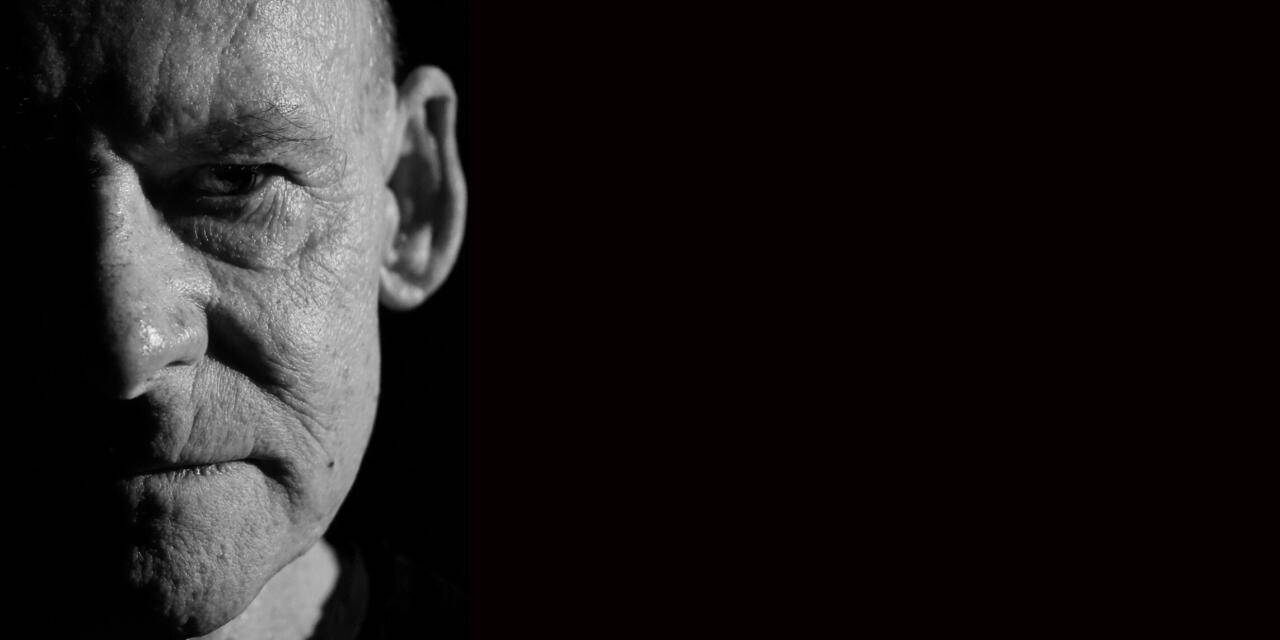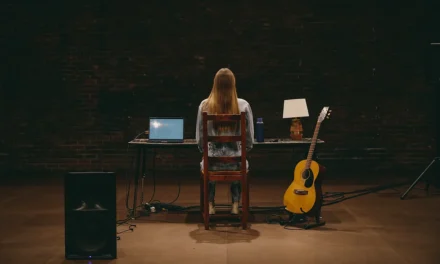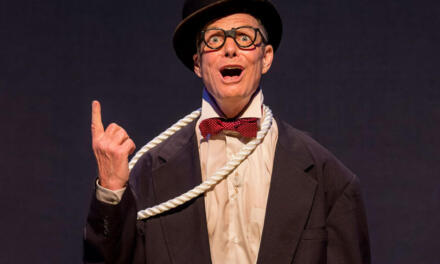The southern city of Ōtepoti/Dunedin has played an important role in the history of Samuel Beckett production in Aotearoa. In 1959, one of the earliest New Zealand productions of Waiting for Godot was performed at the University of Otago’s Allen Hall Theatre, directed by Patric Carey, founder of Dunedin’s longest-running community theatre, the Globe.[1] Allen Hall Theatre has hosted numerous Beckett productions[2] while Dunedin’s now-defunct professional Fortune Theatre staged memorable productions of Beckett’s Play (2012) and Krapp’s Last Tape (2016). Both of those Fortune productions featured Simon O’Connor, one of Dunedin’s most respected actors, who recently performed Beckett’s 1979 novella Company in the very same theatre where that 1959 production of Godot was staged.
Although Company was not originally written for the stage, it has been performed in the theatre several times, including productions by Mabou Mines (USA 1983) and Théâtre du Rond-Point (France 1986). Frederick Neumann, who performed and co-directed Mabou Mines’ production, travelled to Paris to ask Beckett for permission to stage the novella. Beckett was skeptical, saying “what are you going to do to it, Freddy? … It all takes place in the dark”.[3] When Neumann pointed out that theatre audiences usually sit in the dark, Beckett simply replied “Touché”.[4] Neumann was nervous about asking Beckett’s permission to incorporate music into “this wonderful, wonderful text, which is music in itself.”[5] But Beckett agreed, and Neumann commissioned a quartet from Phillip Glass, which “fit quite nicely”.[6] Reviewer Mel Gussow commented that Glass’ “pulsating score embellishes the play with an undercurrent of intensity and also leaves theatergoers time for introspection”.[7]
The Théâtre du Rond-Point’s production of Compagnie was performed by the Comédie Française’s Pierre Dux, who had obtained permission from Beckett himself. The director Pierre Chabert worked closely with Beckett on the production concept. After experimenting with an elaborate machine that would mysteriously move the immobile actor, Chabert rejected the idea and staged the play with Dux sitting still in an armchair.[8] When asked what he learned from Beckett, Chabert states that he “taught me precision and simplicity, the most unequivocal simplicity”.[9] That Beckettian aesthetic is absolutely central to this new production of Company.
The Dunedin production has two directors: Richard Huber, who directed an award-winning production of Waiting for Godot at the Globe in 2011, and Stuart Young, Professor of Theatre Studies at the University of Otago. As Young explains in the programme, this is “the first staging of the novella in Australasia or the Pacific.”[10] Company is a significant challenge for any actor or director. Not only does the novella lack the impeccably precise stage directions of Beckett monologues like Happy Days, there is only minimal punctuation in the text. Clearly the actor and directors have invested many hours into extracting meaning from this flow of words and discovering the careful phrasing in O’Connor’s delivery of the text.
Company begins in deep darkness. We hear the words, “A voice comes to one in the dark” and the lights slowly and barely fade up so we can only just make out the form of the actor, in bare feet, his head shaved, clad in a white singlet and grey trousers. The light glimmers, then fades away, then glimmers again. O’Connor seems to hang in space, like a foetus in an ultrasound scan. The costume draws attention to the body, to O’Connor’s athletic frame, to his skin, to his muscularity, to his sinews. As the light plays over his craggy facial features, they shift and change, like a sequence of different masks.
The text is like a puzzle, spoken in the second and third person as a nameless voice questions someone referred to as “The Hearer”, or at one stage just “H”. Young describes this as:
“a kind of contrapuntal relationship between a second-person voice and a third-person voice. According to Beckett, the latter “devises” or imagines a series of hypotheses, each of which proves false, while the second-person voice conjures up a series of memories, as if to create a history for the other, but the third-person voice rejects them.”[11]
The variation in narrative voice creates a layering effect which resembles the process of remembering, with the tension between different versions of the past, and the slippage between what is true and what isn’t. Chabert’s production highlighted the distinction in voices with Dux performing the “he” voice live and the “you” voice with an invisible microphone.[12] The lighting “cut the face just above the mouth”[13] so that the audience couldn’t see that Dux was speaking, and there were several sound sources, so the voice appeared to move around the space. Chabert felt this worked perfectly because “it’s a voice that speaks to him—but it’s a voice that comes from within him.”[14] In contrast, O’Connor subtly characterizes the different voices of the text without any technical aids. The unobtrusive direction orchestrates Beckett’s composition like a piece of music. The pace is perfect, with O’Connor’s vocal energy building to climaxes and then slowing down with exquisite precision.
O’Connor’s virtuoso performance is the result of a very long rehearsal process over roughly a year and a half—a labour of love—where the directors have guided and supported the actor to prepare what is certainly one of the longest and most demanding monologues I’ve seen in the theatre.[15] The text regularly returns to the imagery of “lying on my back”, yet O’Connor is on his feet the entire time, deftly conjuring up the characters and imagery sketched in Beckett’s text. Although he is a veteran actor, O’Connor at times has a boyish quality which means he can easily suggest the child inside the man, extracting all of the irony from lines like “you’re no older now than you always were”. He has complete control of the text, his warmth and humanity shining through even though his face is in shadow for much of the performance. Despite the rigours of this mammoth monologue, he has an obvious sense of enjoyment in performing it, and a relish in articulating Beckett’s rich language and wordplay. O’Connor draws out a sense of wonder at the world, the artist’s intense curiosity about the details of everyday life. The audience responds warmly to moments of humour in the performance, such as when the narrator muses that a housefly might be good company before swatting it away. As he repeats the word “chuckle”, we chuckle along with him.
O’Connor’s vocal range is extraordinary, drawing every nuance out of the poetic text, crafting each story expertly so it holds us through to the conclusion. At times we are gripped by a narrative, such as the grisly fate of a hedgehog “rescued” by a boy and imprisoned in a box. O’Connor builds beautifully to the climax of a story about a distracted father filling in time while his wife is in labour, culminating in a maid’s delighted announcement, “It’s over”. After a loaded pause, O’Connor repeats, with a deep sense of existential dread, “It’s over.” Like Beckett’s Breath, this repetition encapsulates the whole of a life—from birth to death—in a deliciously satisfying moment. Similarly, he teases us with the question, “God is love, yes or no?”, then extracts all of the melancholic resonance from answering “no”. He draws out a poetic sensuality from a description of two lovers resting under a tree. His expressive body is perfectly matched with the text, at times hovering in space in stillness, at other times moving around the space, illustrating his storytelling with elegant gestures, such as examining a shadow on his hand with mathematical precision.
Many of these stories reflect people, places and events from Beckett’s own life. As Young notes, “Company is seen as closer to autobiography than anything Beckett had written in nearly fifty years”[16], and contains references to many of Beckett’s other works. The autobiographical dimension is captured most strongly in the narrator’s contrasting relationships with his parents, reflecting Beckett’s own familial connections.
While the text is full of imagery of lying on his back, as if asleep or perhaps on his deathbed, there are also frequent references to the feet and the act of walking, with echoes of Beckett’s Footfalls. In the second part, there is an unforgettable image as O’Connor crawls on all fours, like a baby or an animal, while measuring the dimensions of each movement and enjoying the repetition of the rhyming wordplay, “crawling and falling”.
Director Xerxes Mehta writes “In my view, Beckett’s stage works since Play are ghost-plays, hauntings, their spectral quality lying at the heart of their power.”[17] Although not written for the theatre, Company has the same quality of ghostliness and haunting as Beckett’s later short plays. The narrator is haunted by ghosts from his past. Key people in his life come briefly into focus, then fade away. Company’s designer Martyn Roberts sees the notion of the ghost as central to his lighting concept: “the ghost exists in the space between hard reality and memory. People generally encounter ghosts when it’s a time in their life they need to see them, therefore ghosts are conjured from within themselves. Ghosts are partially a manifestation of a past memory infused with present reality; they ask the question of the viewer, why are you here?”[18]
Building on his analysis of the haunted quality of Beckett’s late plays, Mehta writes: “Darkness here is part of the weave of the work, the most important single element of the image. It should be as absolute as can be managed”.[19] Roberts—who is well-known for his edgy experiments with the boundaries of theatrical lighting— is the perfect designer for this text that is obsessed with the interplay between light and dark.[20] Both parts of the play begin in an all-enveloping blackness, which could be the “moonless night” of the text, or the unknown void of death. In this low light we are barely aware of the vast black curtain upstage or the tall, black flats at the periphery of the space. The flats are mostly invisible, but sometimes they are dimly lit as geometric shapes that could suggest cliffs or a cityscape. At times the space is as dark and shiny as the black basalt mentioned in the text. Using extremely low levels of light for most of the performance, Roberts expertly manipulates them to create beautiful imagery from a single actor moving in a large space. The bare stage becomes a canvas on which the lighting creeps and fades, sometimes producing a glow over a large area, at others the actor hangs suspended in a single spot. A gobo transforms the stage into a textured space that might suggest a forest or the outer limits of the universe. The play becomes a dance between light and the body. At one point the narrator refers to “that perfect dark”, which is an apt description of Roberts’ lighting design.
In contrast to the “pulsating” music of Phillip Glass in Mabou Mines’ Company, this production takes a strikingly minimalist approach to sound. Sound designer Kerian Varaine recorded O’Connor rehearsing the text, then removed the vocals, leaving only the breath and ambience of the performance. These recordings are played during the performance at extremely low levels, so I was unsure what I was hearing. At times I thought I heard wind, at others a low rumble like the sound of traffic. The minimal soundscape made me hyper-sensitive to any sounds, some of which—such as the juddering of a helicopter—were coming from the world outside of the theatre. Yet all of these indefinable sounds were mere echoes or traces of the performance itself, reflecting what Stuart Young refers to in the programme as the “intricate web of phrases and motifs that echo through the novella.”[21]
With the constant switching of narrative voice and timeframes, watching the performance requires concentration, but it also has a calm, mindful, meditative quality. Several people I spoke to afterwards commented that the play unlocked memories for them and caused them to reflect on their own lives. In this meditative mode Company can be relevant to anyone prepared to pay attention, to invest in the world of the play and to enter the realm of memory. The directors chose to insert a 10-minute interlude in the 100-minute performance—I assume to give the actor and audience a break. Beforehand, I wondered if this was necessary, if it would break the mood. But for me, it actually enhanced the experience. The audience mood during the break was quiet, contemplative. Many people stayed in the theatre, perhaps reluctant to break the spell, to let the outside world intrude.
As the lights fade on the final image of O’Connor suspended in a poignant loneliness (the last word of the text is “alone”), Company provides an immensely satisfying experience. While on one level this is a perfect minimalist production of a minimalist text, the echoes and resonances are on an epic scale. Like many of Beckett’s other works, it gives a sense of the paradoxical pain and joy of existence, while also being a rich exploration of the nature of memory itself. Beginning with imagery of birth and childhood, the play concludes with a sense of ageing and death, a meditation on love and the lack of love, on the whole cycle of life. Whether moving or still, the narrator is on an endless search for “company”, seeking connection. Even though O’Connor’s face is often in darkness, he achieves a remarkable degree of intimacy. I felt that he was speaking to me personally. As he peers at the audience in the darkness he seems to be imploring us to connect with him, to welcome our shared humanity, to have a chat, to come on life’s journey with him. This production masterfully proves how beautifully Company works as a theatrical piece.
afterburner presents
Company
By Samuel Beckett
Performer: Simon O’Connor
Direction: Richard Huber and Stuart Young
Light: Martyn Roberts
Sound: Kerian Varaine
Allen Hall Theatre, Ōtepoti/ Dunedin Fringe Festival 22 – 23 March 2024
[1] Throughout its history the Globe has produced Godot at least five times (1959, 1966, 1977, 1996, 2011), as well as productions of Endgame (1961, 1968, 1969), Happy Days (1964), Act Without Words (1967) and Krapp’s Last Tape (1972). In April 1996, a Globe production of Godot was cancelled by Beckett’s English agent when they discovered that the director Fiona Pulford had cast a woman (Melanie Dodge) as Lucky. After a fruitless telephone call to the agent, Pulford was forced to re-cast the role with a male actor and limited the remainder of the season to five nights. In response Pulford wrote: “In a living theatre, won’t the interpretation of a play naturally evolve as its audience does? … Gender roles have changed, even in the short time since Beckett died; the need for cross-gender exploration in a play such as this one is huge.” Pulford, Fiona. “Response to the Waiting for Godot/Lucky Debate” Theatre News Vol III, No. 4, May 1996, 18. The 2011 Globe Theatre production of Godot was directed by Richard Huber with set and lighting design by Martyn Roberts, and won Best Production of the Year at the Dunedin Theatre Awards.
[2] Including Endgame (1984, 1992), Krapp’s Last Tape, Rockaby (1997), Act Without Words (2003), Play (2010). Source: Theatre Aotearoa https://tadb.otago.ac.nz/theatre/Login/Index.php
[3] Neumann, Frederick. “Interview.” Directing Beckett. Ed. Lois Oppenheim. Michigan: University of Michigan Press, 1997, 25-39, 28.
[4] Neumann 28.
[5] Neumann 29.
[6] Neumann 29.
[7] Gussow, Mel. Review of Company by Samuel Beckett. The New York Times 17 January 1983, Section C p. 13.
[8] Chabert, Pierre. “Interview.” Directing Beckett. Ed. Lois Oppenheim. Michigan: University of Michigan Press, 1997, 66-79, 68-71.
[9] Chabert 73.
[10] Young, Stuart. Director’s note. Company programme 2024.
[11] Young 2024.
[12] Chabert 71.
[13] Chabert 71.
[14] Chabert 71.
[15] O’Connor deservedly won the best performer award at the 2024 Dunedin Fringe Awards.
[16] Young 2024.
[17] Mehta, Xerxes. “Ghosts”. Directing Beckett. Ed. Lois Oppenheim. Michigan: University of Michigan Press, 1997, 170-185, 170.
[18] Email from Martyn Roberts, 28 March 2024.
[19] Mehta 170.
[20] See https://thetheatretimes.com/dark-matter-interview-lighting-designer-martyn-roberts/
[21] Young 2024.
This post was written by the author in their personal capacity.The opinions expressed in this article are the author’s own and do not reflect the view of The Theatre Times, their staff or collaborators.
This post was written by David O'Donnell.
The views expressed here belong to the author and do not necessarily reflect our views and opinions.


















